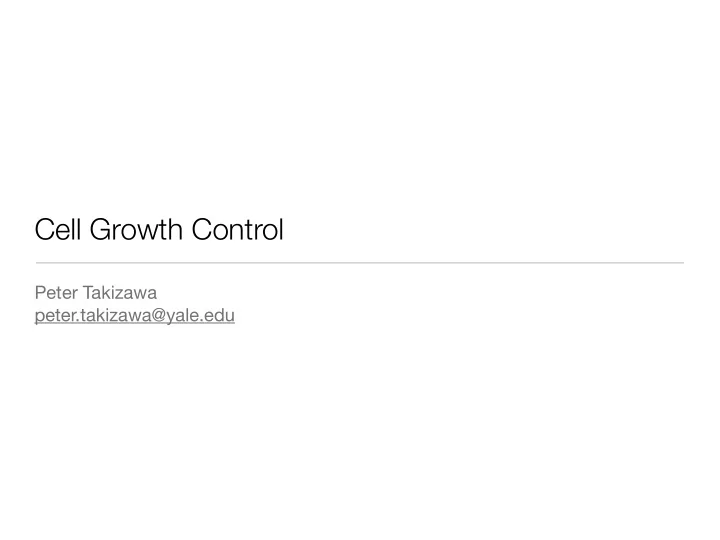

Cell Growth Control Peter Takizawa peter.takizawa@yale.edu
What we’ll talk about… • Cyclin and cyclin-dependent kinases and control of the cell cycle • Start and regulation of cell division • Signaling pathways that stimulate and inhibit cell division • Checkpoints and regulation of the cell cycle • Mitosis
Cell division requires cell growth, chromosome duplication and separation. Cell Cycle
Cell cycle is divided into separate phases. S G0 G1 G2 C M
Cyclins and cyclin dependent kinases (CDK) drive cell cycle events. M G2 Cyclin CDK G1 S
Different cyclin CDK complexes initiate and control the phases of the cell cycle. Cyclin E Cyclin A Cyclin B APC Cdk2 Metaphase/ Start G2/M Anaphase G1 G2 G1 S M A C CDK O ff CDK On CDK O ff
Waves of cyclin expression and degradation mediate ordered progression of cell cycle. Cyclin protein level Cyclin E Cyclin A Cyclin B Cyclin E Cyclin A Cyclin B APC Cdk2 G1 G2 G1 S M A C
Positive feedback loops increase the amount of active cyclin-CDK. Cdc25 inactive Cyclin Inactivating Active CAK Cdc25 CDK Wee1 active Activating
Switch-like activation of CDKs ensures rapid and irreversible initiation of cell cycle events. CDK protein protein concentration CDK activity Cyclin protein + CDK activity CDK Cyclin time Positive Feedback CDK protein protein concentration CDK activity Wee1 Cdc25 n i e t o r p + n i l c y C CDK Cyclin CDK activity time
Ubiquitylation and proteosome are required to digest cyclins and decrease CDK activity. Proteosome Ubiquitin Cyclin CDK
Start and the Decision to Divide
Start marks the initiation of DNA replication and an irreversible commitment to cell division. Mitogens Anti-mitogens G1 Start S G2 M C Cyclin D Cyclin E Cyclin A Cdk4 Cdk2 Cdk2
Mitogens activate signaling pathways that lead to expression of Cyclin D. Mitogen Cyclin E DNA Signal transduction pathway replication CDK2 Cyclin D Cyclin A CDK2 CDK4
Receptor tyrosine kinases activate MAP kinase pathways to increase expression of cyclin D. EGF MAP kinase kinase kinase Ras Guanine nucleotide exchange factor MAP kinase kinase Receptor tyrosine kinases MAP kinase Phosphorylation Cyclin D Transcription Myc
Anti-mitogens activate signaling pathways that inhibit formation of cyclin D-Cdk complexes. TGF- β Phosphorylation Smad Smad4 Receptor tyrosine kinases Transcription Cyclin D Ink4 Cdk4
E2F proteins regulate expression of cyclin E. Cyclin E E2F1 or E2F2 or E2F3 Enhancer Repressor Cyclin E E2F4 or E2F5 X Enhancer Repressor Cyclin E
pRB inhibits cell division by promoting binding of E2F to repressor and inhibiting binding to pRb E2F1 pRb X X E2F4 Enhancer Repressor Cyclin E
Cyclin D/CDK inactivate pRB to allow E2F to stimulate transcription of cyclin E. pRb pRb Cyclin D E2F1 CDK4 E2F4 pRb Cyclin E E2F1 E2F4 X E2F1 Enhancer Repressor Cyclin E
Positive feedback loop keeps cyclin E - CDK active. Cyclin D CDK4 Phosphorylation pRb pRb pRb E2F1 E2F1 E2F1 Positive Feedback Loop Phosphorylation Transcription Cyclin E CDK2
Mitogens and Increase in Cell Size
TOR complex integrates the nutritional status of the cell and regulates cell growth. [ATP] O 2 Growth Factors [Amino Acids] mTORC Active Protein Synthesis Lipid Synthesis
Mitogen-activated signaling pathways can turn on TOR complexes to promote cell growth. Mitogen PI3 Kinase PDK AKT Adaptor Receptor Tyrosine Kinase TSC1/2 Inactive mTORC rheb-GDP rheb-GTP Active
Checkpoints in the Cell Cycle
Checkpoints ensure completion of one stage of cell cycle before starting the next. Unreplicated DNA DNA Unattached DNA Damage Damage Chromosomes M-CDK APC G 1 /S-CDK S-CDK G1 G2 G1 S M A C
DNA damage activates p53 to arrest the cell cycle. Damaged DNA Mdm2 ATM/ATR kinases Chk1/Chk2 kinases Mdm2 Mdm2 p53 p53 Mdm2 p21 p53 p53 Cyclin E CDK2 p53 Enhancer p21
DNA damage also triggers degradation of Cdc25 to slow the cell cycle. Damaged DNA ATM/ATR kinases Chk1/Chk2 kinases Cdc25 Proteosome Ubiquitin Ligase
p53 is activated by oncogenes and slows cell division. Oncogenic Transformation: Ras, Myc, E2F Cyclin D p14-ARF Mdm2 p14-ARF CDK4 p53 p21 Cyclin E CDK2 Inactive
P53 triggers apoptosis by inducing release of cytochrome c from mitochondria. p53 Bax Cytochrome c Apoptosis
Mitosis
Mitosis proceeds in several defined stages that involve changes in microtubule organization. Interphase Prophase Prometaphase Metaphase Cytokinesis Telophase Anaphase B Anaphase A CS CF
Three types of microtubules comprise the mitotic spindle. Kinetichore Chromosomes Astral microtubules Microtubules Kinesin Interpolar microtubules Centrosome
Mitotic Checkpoint
Incomplete or incorrect attachment of microtubules arrests cells in metaphase. Metaphase Arrest High cyclin B-CDK2 activity Transition to Anaphase Decrease in cyclin B-CDK2 activity
Cohesins tether sister chromatids to prevent premature separation. Cohesins Histones Sister Sister Chromatids Chromatids
Unattached chromosomes prevent activation of anaphase promoting complex. Anaphase- promoting complex, Metaphase Arrest inactive Anaphase- promoting complex, active Cdc20
Anaphase-promoting complex ubiquitylates cyclin B and securin to trigger transition to anaphase. Cyclin B Cdk2 Ubiquitylation Cdc20 Anaphase- promoting complex Proteosome Ubiquitylation Securin Separase Separase Active
Separase digests cohesins which allows tension from the spindle to separate chromosomes. Separase
Take home points • Cyclins and CDKs initiate di ff erent stages of the cell cycle • Positive feedback is critical for commitment steps in the cell cycle • Mitogens and anti-mitogens work through signaling pathways to influence the decision to divide • Oncogenes trigger cell division in the absence of mitogen • Tumor suppressors slow cell division by inactivating cyclin-CDKs • Checkpoints monitor the state of the cell and can arrest the cell cycle
Recommend
More recommend